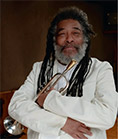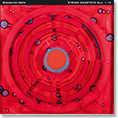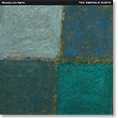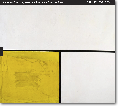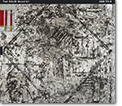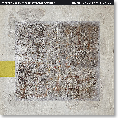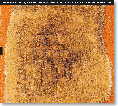SHADOWGLOW
New York City may not be the capital of the United States but it certainly can, with good reason, be seen as the capital of the modern art and music world. This includes being the unchallenged center for improvised music in its various forms and guises. Therefore, it is not surprising that Raoul Björkenheim and Lukas Ligeti, two cosmopolitans by background and by inclination, came to meet and first work together in New York City. Like so many others, Björkenheim and Ligeti were drawn to New York not only by the opportunities that is offers to work with like-minded artists but, perhaps even more importantly, by the unique energy and drive that the city offers.
Both Björkenheim and Ligeti now make New York their permanent home and have actually divided much of their lives between the United States and Europe. Björkenheim was born in the United States of Finnish parents and lived there until the age of 15, but then spent most of the next 30 years based in Finland before returning to live in New York in 2001. Ligeti, on the other hand, was born in Austria of Hungarian parents and grew up mainly in Vienna, but spent time in the United States as a child and cultivated close ties to the country; he then lived in California from 1994 until 1996 and settled in New York in 1998.
And, as both of these musicians/composers share an interest in a broad range of music, from experimental rock and free improvisation to fully-notated, the fact that they came to meet and co-operate should not be seen as an accident. Initially, it was the West Coast guitarist Henry Kaiser who saw the logic of the two working together: having played and recorded with both Björkenheim and Ligeti, Kaiser was familiar with their compatible interests and suggested that the two get together. Lukas Ligeti himself says the following of Shadowglow:
"Raoul and I first played together on a dark afternoon in December 2002 in a small, windowless rehearsal space in midtown Manhattan. But, for both of us, the music we began making immediately created infinite windows in the walls of this room, opening vistas to strange yet pleasant worlds full of unusual shapes and colors. What has followed since then is an exploration of spontaneously created timbres and meters coalescing into harmonies and forms we might each have been searching for, but are now finding.
Everything you hear on this album is fresh, the product of only a few months of occasional rehearsing and gigging, during which we kept coming up with new musical possibilities, some of which evolved while others emerged only to slip back out of our grip. We share a wide, nearly omnivorous interest in things musical and otherwise; the wish to develop a large personal vocabulary on our instruments rather than settling into a narrow esthetic; a special affinity for traditional musics from various parts of the world; and uncompromising experimentalism while aiming for beauty - rejecting the politics of rejection.
This is improvised music, but both of us are also active as composers in the completely notated domain, taking these different ways of working equally seriously and believing that the cross-fertilization of these methods more than makes up for whatever may be sacrificed in stringency. Jazz looms in the picture, as a language to refer to, but more than that, as a springboard to certain types of interactivity.
Our interplay is conversational; in general, we prefer to have several distinctly different things happening simultaneously and having these elements maintain precarious yet discernible relationships to one another. For us, the musical interplay documented here is the auspicious beginning of a path of exploration leading through the infinite windows of that windowless rehearsal space, through the skyline of our home town of New York, out into the breadth and wilderness of the world - this world and those other colorful, strange worlds out there, somewhere."
In addition to their interest in improvised music, Björkenheim and Ligeti share an interest in the musics of different parts of the world. In Björkenheim´s case, this has resulted in playing both guitar and occasionally electric bass in various groups featuring different styles of African music and often also musicians from the countries in question. Similarly, Ligeti has, during his more than a dozen trips to various parts of Africa, not only taught local musicians and studied the local music styles but also worked extensively with African musicians. This is important for the understanding of the music on this recording. Possibly, their mutual interest in the musics of the world has never been as clearly demonstrated as on this recording, wherein references to Asian, African and European indigenous musical styles and, in particular, rhythmic patterns can easily be detected. Still, this is not what has come to be known as world music. Instead, we have two artists reflecting their shared and/or separate influences and interests in an open, improvisational context that is always strictly modern in approach.
For this session, no music was "written", but preparation consisted of intensive rehearsal sessions where the two musicians improvised based on rhythmic patterns or melodic ideas that they found to be of common interest. Prior to these sessions, Björkenheim and Ligeti had also performed publicly at such venerable "downtown" venues as Tonic, Right Bank Café and Downtown Music Gallery, sometimes sharing the stage with others, including guitarist Elliott Sharp and saxophonist Ned Rothenberg, and sometimes focusing on the basic duo. Each time, the common feature has been the unpredictable rather than settling for the well-tried. In this sense, Björkenheim and Ligeti share the artistic sensibilities of many fixtures of the New York "downtown" scene, although their music stands very much on its own.
Listeners familiar with Björkenheim´s past recordings and live performances will find something familiar but also something very new and, maybe, surprising on this recording. The expansive, high-energy improvisations of the past are largely replaced by more intricate interplay within the rhythmic patterns supplied by Ligeti. Often, Björkenheim moves to the background allowing Ligeti to take the lead over a carpet of guitar sounds. The shamanistic quality that Björkenheim´s playing has been known for still surfaces at times, but is more tempered than in the past. And those familiar with Ligeti´s previous work will also find new openings here; he has greatly enriched his timbral palette on the drumset, and the duo context affords him the space to formulate some of his structural ideas with clarity.
Björkenheim and Ligeti plan to continue to play as a duo and, maybe, augment it with a third member for some projects. They wish to develop this music through public performances and one can only hope that there will be many opportunities to do so

